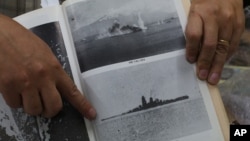American explorer Paul Allen said his research team has found the sunken hull of the Japanese Imperial Navy's massive battleship Musashi, sitting where it was sunk more than 70 years ago by U.S. forces in a key Pacific battle of World War II.
Allen, the billionaire co-founder of Microsoft, said the warship -- the heaviest and most lethal battleship ever constructed -- was found Sunday at a depth of about 800 meters off the coast of the Philippines.
WATCH: video clip of Microsoft billionaires discovery under the sea
A spokesman for Allen's team said further details will be released within days.
The discovery, replete with identifying photos, came after an eight-year hunt for the ship.
Philippine Presidential Spokesperson Sonny Coloma told journalists at a news conference that officials were in contact with the relevant agencies.
“The National Museum is working closely with all stakeholders to ensure that all the provision of our existing laws, the provisions of our existing laws are enforced and complied with. These stakeholders include Romblon province which is proximate to our Sibuyan Sea where the shipwreck has been found according to reports, the Japanese government as this involves the shipwreck of a World War II Japanese battleship and Mr. Allen's organization,” Coloma said.
The Musashi was sunk at the outset of the Battle of Leyte Gulf, one of the largest naval battles in history, pitting American and Australian forces against the Japanese who occupied the Philippines for three years until 1945.
Historians say about half of the ship's 2,400 crew perished in the five-hour battle, as the ship was ripped apart by nearly 20 torpedoes and nearly as many bombs. The battle crippled Japan's wartime fleet and set the stage for the U.S. invasion of the Japanese-occupied Philippines.
Jose Custodio, a military analyst and an expert on the Japanese occupation of the Philippines in World War II, said the discovery of the warship may invoke memories of the past war but does not expect it to spark anti-Japanese sentiments in the Philippines due to the two nations' close relations.
“Going back again, is that there's so many shared relations, for example the economy, and even the military, because of the Chinese threat to the Philippines, and the Chinese threat to Japan, that our governments are getting closer and closer of military and security ties,” Custodio said.
The Philippines and Japan are expected to hold their first joint military exercises in April to strengthen security ties between the two nations.
Custodio said the discovery should serve as a reminder of the lessons of the past.
“The intelligence and capabilities of man, if he puts his mind into it, at the same time also, is an example of the folly of war of such weapons of destruction, that the Japanese invested so much material and national pride in coming up with such an impressive battleship, and it took tiny airplanes with the Americans to sink it,” he said.
The 73,000 ton Musashi and its sister ship the Yamato rank as the largest and most heavily armed battleships ever built. They carried nine 460-millimeter main guns, along with four aircraft and a vast array of smaller artillery. Its largest guns fired shells weighing 1.5 tons. The Yamato was sunk by U.S. aerial torpedoes off the coast of Okinawa in April 1945.
Some material for this report came from Reuters.
